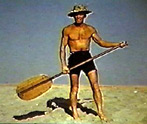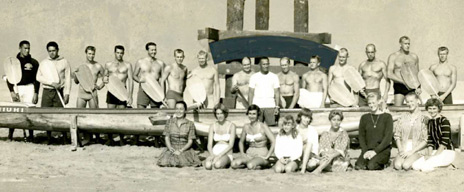The first outrigger race held in California was on September 20, 1959. This first race was a long-distance race from Avalon on Catalina Island to the Newport Dunes on the California Coast. The famous Duke Kahanamoku served as the Grand Marshall of the first California Outrigger event and founded the Catalina to Newport Dunes race – the original California Outrigger Classic. The subsequent races were underwritten by the Balboa Improvement Association and Ira Dowd, part owner of the Newport Dunes.

The first race involved two canoes shipped to California from Hawaii through the efforts of Albert Edward “Toots” Minvielle. Both of them were koa wood canoes with the names Malia meaning calm waters and Niuhe, meaning shark.
The malia team was composed of Hawaiian All-Star outrigger paddlers organized by Toots. Some of the members of that first Hawaiian team to paddle the Catalina Channel in 1959 were Chris Bodie, Blu Makua, Archie Kuana, Joe Gilman, Sonny Heniques, and Dougie Carr. The California team paddled the Niuhe. This first mainland team included George Kopa, Tom Johnson, Dan Uadis, Frank Saddler, Mike Johnson, Dave Arne, Doug Wood, Ron Druman, Lorrin Harrison, and others.
The Hawaiian team won the race in a time of 5 hours. The newly formed California team in the Niuhe finished closed behind in a time of 5 hours, 11 minutes.

Lorrin Harrison, the steersman and original member of the first California team had the following remembrances of the early beginnings and that first race, “when I first heard about canoe racing here, I had a dugout canoe that I built in 1950. We were surfing it down in Doheny. Noah Kalama came by, he knew my sister from Hawaii, and I knew him from body surfing. He said, “Lorrin can you get a team together of guys down here you think would like to paddle? We’ll have a race with a Hawaiian team.”
“I said, ‘Yeah, we can do that!’ So we started coming here to the Dunes, paddling here till 9 o clock every night. There were about 15 guys all paddling. Other guys would build a fire and we’d stay here and paddle when the wind was howling. We worked for two months. We were so sick of paddling there. I thought we would never get out and see the ocean. Finally, Noah let us go out and it was rough outside, too. That’s the way it all started, right here in these Newport Dunes.”
Then they brought the Hawaiian team over so we all hooked behind some big boat, and towed all the people and the two boats over to Avalon. The race started the next morning after we were there. It was just two boats in the race from Avalon. Coming across we were making changes. We had about 25 people to draw from. About halfway across, the escort boat ran ahead to drop people in the water and made a big wake. The wake flipped the boat straight up on the edge with the ama (outrigger) straight out of the water. I stayed – stuck in, but my number one man was about 20 feet off the stern and it threw all the other men out too. So Noah put a whole new 5 guys in and we kept going. At that time we were right even with Blu Makua and the Hawaiian team. When we came to the south end of the Newport Dunes, they finished 11 minutes ahead of us. I had been in the boat for 5 hours and 11 minutes with no drink of water and I thought I’d just die when we hit the beach ’cause of the paddle Noah gave me, he said ‘You gotta have a big paddle for this race’. That sucker weighed 10 pounds at least. I still got the paddle, I got the proof, if anyone wants to paddle 30 miles with it, they can have it.”

While the first Catalina to Newport Dunes Race was a culmination of efforts and farsightedness on the part of several outstanding persons in canoe paddling, the spirit behind the spread and development of outrigger canoe paddling as a sport, both in Hawaii and California, is the famous Albert “Toots” Minvielle.
Toots Minvielle and 1958 were pivotal points in the history of outrigger canoeing, especially for California. In 1958 Toots met Tommy Zahn from Santa Monica, shortly after Tommy had paddled the Molokai Channel on a surfboard. Tommy Zahn responded immediately – there was sufficient interest. He arranged a luncheon meeting in early 1959 with Ira Dowd, the owner of the Newport Dunes, Sam Miller, (then commodore of the Balboa Bay Club), and Al Oberg, Harbor Master of Newport Beach in 1959. All the right people were there and California’s Outrigger racing history had begun.
Noah Kalama, sent to California by Toots Minvielle to coach the first California Outrigger team, and Tom Johnson, an original member of the first California outrigger racing team, was the first to perceive the need for California-based canoes. The boats used for that first Catalina race were scheduled to be shipped back to Hawaii after the competition was completed. Noah Kalama and Tom Johnson realizing the development of California outrigger racing would hinge upon a local boat supply were quick to act. They made a mold of the Malia hull – and California outrigger boat building was born.
Although Toots Minveille initiated efforts to bring Hawaiian Canoe Paddling to the mainland in 1958, 1959 was the year paddling arrived – the same year that Hawaii joined the United States of America. What may have been initially seen as merely a gesture – sharing a facet of Hawaiian culture with the mainland through the Aloha Celebration and the aloha spirit of Toots Minveille- has given mainlanders, especially Californians, a tease, a feel and a love for Hawaiian traditions.
Mahalo Hawaii, Mahalo Toots Minveille for outrigger canoe paddling – a wonderful slice of Hawaiian life.
– Excerpts from article written by Michael (Jake) Jacobs
